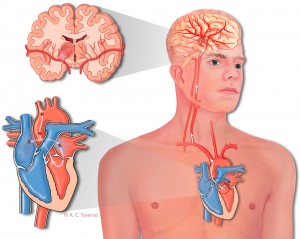Monitoring Symptoms of Stroke
 Recently a close friend who used to work at Target Digital Marketing experienced two TIAs, Transient Ischemic Attacks. While not as serious as a stroke a TIA is considered a warning sign of stroke. Although it only lasts a few minutes and the symptoms are mild, most people who have a TIA are likely to suffer a full blown stroke within the next year if left unattended.
Recently a close friend who used to work at Target Digital Marketing experienced two TIAs, Transient Ischemic Attacks. While not as serious as a stroke a TIA is considered a warning sign of stroke. Although it only lasts a few minutes and the symptoms are mild, most people who have a TIA are likely to suffer a full blown stroke within the next year if left unattended.
Monitoring your heart and the cardiovascular system for blockages naturally includes keeping arteries running to your brain clear and healthy. If they are towing debris that causes blood flow to diminish and nutrients are cut off to a part of the brain, you are likely to experience a TIA or worse, a stroke.
Like a stroke a TIA is caused by a clot, but it is a temporary blockage, thus the descriptive word, transient. A TIA usually causes no permanent injury to the brain. The best thing to do, however in the event of a TIA is to treat it like a stroke and get to a medical facility as soon as possible.
Symptoms of stroke can sometimes go unnoticed – especially if the stroke is mild. Even medical professionals have confessed to ignoring their own signs, that in retrospect appeared to be obvious.
According to the American Heart Association be aware of the warning signs:
Numbness or weakness of the face, arm or leg, especially on one side of the body
Sudden confusion with trouble speaking or understanding speech
A rapid onset of dizziness, loss of balance or coordination, trouble walking
A severe headache seems to come out of the blue
Trouble seeing, blurred vision or loss of peripheral vision
My friend had two of these signs- the compromised vision and trouble speaking. He was out grocery shopping at the time and when he tried to interact with the butcher, he found himself unable to retrieve words to describe what he wanted. This frightened him and he should have driven to the nearest emergency room, but since he wasn’t thinking clearly and the entire experience was new to him he waited. To his credit, though he got in to see his doctor the very next day.
Monitoring your blood pressure and heart rate, watching your diet and getting exercise are the basics of preventing a TIA from becoming a stroke. A transient ischemic attack is no laughing matter, and according to Doctors should be treated as a stroke. My friend’s doctor simply told him to take a baby aspirin once a day, incorporate moderate exercise into his weekly routine, come in for regular check-ups and keep to a low fat diet.
Since then he has taken it upon himself to learn more about a stroke preventative diet. Science changes as it learns more about human reactions to food, stress and environment, so it’s highly recommended to go to the Stroke Association Organization on-line to learn more about symptoms and preventative courses of actions available. This doesn’t take the place of seeing a medical doctor, but being educated is t good power base to establish.
Initially a stoke victim will be on a regiment of drugs, but like my friend there are many people who are not keen on filling their medicine cabinets with prescription bottles and want to take a more natural approach. This is not a suggestion to abandon your medical doctor’s advice, so be sure to get his or her blessing when considering alternative treatments. A few of the complimentary medicines offered for TIA symptoms as well as stroke victims are through nutritional guidance, acupuncture, herbal prescriptions, massage, yoga and meditation. The natural approach isn’t for everyone, but if followed diligently will give you undeniable benefits.
Have you or someone you know had a TIA or stroke? What plan of action did they take to bring balance and well-being back into their lives? Check out this next heart health article and leave us a comment below.